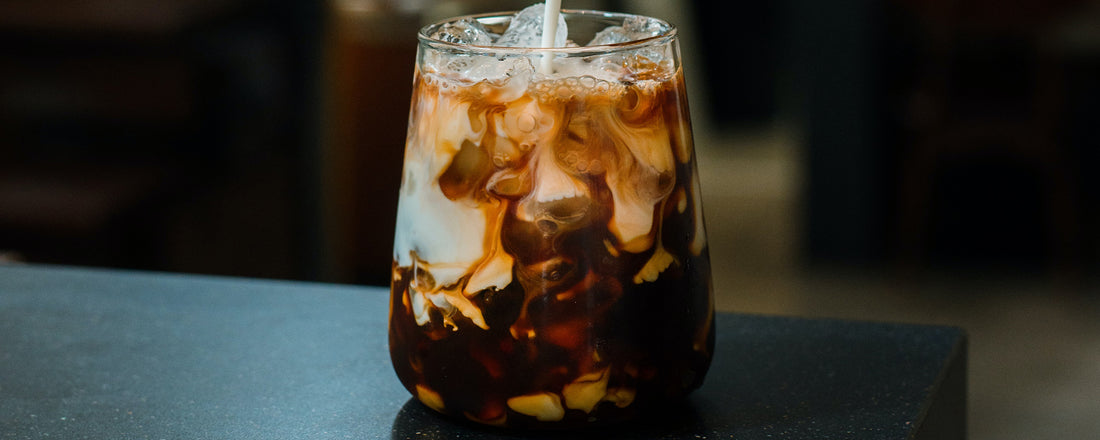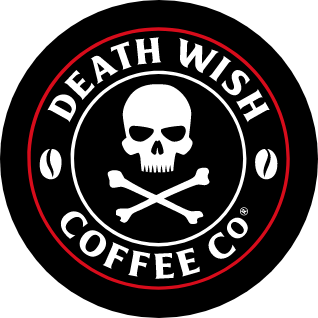
The Ultimate Guide to Cold Brew Coffee
Coffee TalkEverything You Need to Know About Making Cold Brew Coffee
The world needs to just chill. We’re here to help you celebrate all things cold brew coffee. That’s because having coffee brewed without heat might be good for you—as well as delicious.
What is Cold Brew Coffee?
Cold brew coffee is coffee brewed by steeping coffee grounds in cold or room temperature water for an extended period of time. The result is cold coffee that’s a bit chemically different from ordinary hot coffee and iced coffee, with a totally different flavor profile. Those asking, “What’s a cold brew?” may also be wondering how to make it. The truth is that you don’t need any special equipment besides a glass jar and a quality filter. And you need patience—lots and lots of patience.
 [Photo Credit: Pariwat Pannium via Unsplash]
[Photo Credit: Pariwat Pannium via Unsplash]
Why Cold Brew Coffee?
Cold brew isn’t just a sexy fad. In fact, cold brewing is the third most popular method of preparing coffee according to the National Coffee Association. That’s no real surprise because there are many cold brew coffee benefits. Here are some of the highlights:
There’s less acidity in cold brew.
Some estimate that there’s around 60% less acid in cold brew versus a regular cup of joe. In a study, cold brew had a pH of 6.31 and hot brew had a pH of 5.48 (with the higher number meaning it has less acid). So yes, cold brew is less acidic.
Why is cold brew less acidic? Remember that we’re chemically using an entirely different process when we cold brew coffee. Less acidic cups of coffee happen because cold water pulls out less of the acid in coffee than hot water does. That’s pretty exciting if you’re supposed to be having less acid, and cold brew is arguably healthier for that reason.
It’s better for those with sensitive stomachs.
If you have a digestive sensitivity (often as a result of an illness like IBS or acid reflux), the lower amounts of acid in cold brew can be a much better choice than hot. Cold brewing doesn’t seem to have an effect on other factors like antioxidants or cholesterol.
On the other hand, though, remember that cold brewing affects flavor. If you find yourself adding packets of sugar and globs of cream to your iced coffee to make it taste better, you may find yourself adding less to cold brew because of its natural sweetness and smoothness. Cutting back on sugar and dairy like that can definitely affect your cholesterol and other factors.
It has a smooth flavor.
As a result of the acid and other chemical differences, you get less of that sharp, almost vinegar-like taste and end up with something very creamy and calming.
It stays good for longer.
Leftover hot coffee goes bad after a few days, but DIY cold brew stays good for up to a week, as that’s how long the flavor of cold brew coffee lasts. After more than a week, it will begin to attract mold and bacteria, unless you have a completely sterile setup. We don’t condone any weird cold brew kombucha experiments. Don’t worry: With how good it is, it likely won’t last that long anyway!
The best method for how to store cold brew is to keep it in a covered pitcher in the fridge. Do NOT store homemade cold brew at room temperature! Also, make sure you brew with fresh coffee grounds. Coffee grounds stay fresher longer than brewed coffee (a few months, typically), but doing a cold brew always has better results with fresh, course grounds.
It’s strong.
Is cold brew stronger? As with anything in life, it depends. On average, the caffeine levels tend to be about the same for hot coffee compared to cold brew. Iced coffee, on the other hand, often suffers from dilution, though some like to make an extra-strong cup before icing it.
The caffeine content in cold brew coffee all comes down to your ratio; if you’re drinking a 1:3 concentrate without cutting it, it can have a lot more caffeine than a watered-down iced coffee. There may be more or less caffeine per cup depending on your personal brewing process.
It’s versatile.
You can use it for all kinds of recipes, especially sweet ones.
It’s refreshing without being watery.
No drowning in ice cubes for you, beloved coffee!
 [Photo Credit: Nathan Dumlao via Unsplash]
[Photo Credit: Nathan Dumlao via Unsplash]
How Do I Make Cold Brew Coffee?
Cold brew coffee is definitely not using leftover coffee and putting it in the refrigerator. You don’t have to go to your local coffee shop to get a high-quality cold brew either—here’s how to make a ridiculously simple homemade cold brew coffee at home in just a few steps.
The Best Cold Brew Coffee Recipe to Make at Home
Ingredients:
- Death Wish Coffee
- Mason jar
- Coffee filter
- Ice
Directions:
- Grind the coffee. Grind fresh coffee coarse (about 6 seconds in your grinder). Coarse coffee will make it taste the absolute best. Pre-ground coffee is too fine for this method.
- Fill your jar (or any container) about 1/4 to 1/3 with coffee. The best thing about cold brew is that it’s forgiving. Eyeball it—you’re a risk-taker. You’ve got this. (Scaredy-cats, don’t worry: We’re gonna talk more about finding the perfect coffee/water ratio later!)
- Add water. Fresh, filtered water below 40 F should be used. Fill up the rest of the container. The less water you use, the stronger it will be.
- Shake it up. Make sure the grounds are fully mixed with the water.
- Let it steep for 24 hours. Now we wait. Shake it every once in a while to prevent separation.
- Filter out the coffee. Using a coffee filter, pour your cold brew into a mug or glass. A regular coffee filter will work, but a Chemex filter is best if you have it. If you make enough for more than just one cup, filter it over the container you will be storing it in.
- Enjoy! (Yes, DIY cold brewing is really that simple.)
Grim Reaper Pro Tip: To make that cold brew even stronger (and less watery), freeze Death Wish Coffee in an ice tray overnight to make coffee ice cubes for your cold brew.
Cold Brew Coffee-to-Water Ratios
We talked a little bit in both recipes about how to choose how much coffee to use. It’s a lot more wishy-washy than one might think, and it very much depends on your individual preference. How strong would you like your cold brew? Measurements for cold brews tend to use a lot more coffee than for hot drip brews—often twice as much. Caffeinds, don’t be surprised if 1:3 ends up being your preferred coffee/water ratio!
- 1:8 ratio—This is acceptable for human consumption. This is a better ratio if you don’t want it too strong or if you’re doing the French press method of cold brewing. (This works out to be about one pound of coffee to one gallon of water for big batches.)
- 1:5 ratio—Reverse the polarity of the caffeine flow. This is very possibly the best cold brew ratio for those hoping to immediately drink it straight rather than making a concentrate.
- 1:4 ratio—We’re giving it all she’s got, captain. This is a bit strong to drink and a bit weak to use as a cold brew concentrate ratio, unless you like it less strong.
- 1:3 ratio—My, you are a bold one. This is probably the perfect cold brew coffee concentrate ratio, unless you like to drink coffee that’s very, very bold, which we assume you do.
- 1:1 ratio—You’re not human, are you? While you do certainly need more coffee grounds than with drip coffee for cold brew, proportions like a 1:1 ratio will probably not be as effective as you think. Usually, when you see a 1:1 ratio referred to in a cold brew coffee recipe, ratios are being used to describe how to cut your already-brewed concentrate with water or milk. Consider a 1:3 or even a 1:2 ratio for a really powerful concentrate.

Other Cold Brew Methods and Tips
If there’s one thing about people who love coffee, it’s that we love to perfect a process and make it an art form. We should probably mention then that there are multiple methods for cold brewing.
- Immersion Method: What we’re describing in our recipes is the immersion method for making cold brew. Basically, coffee is immersed in water for a long time—that’s it. We like it because it’s super simple; you only need a jar and a filter.
- French Press Method: Another legit option is to use a French press. Cold brew coffee French pressed is basically the same as the immersion method, only you’re using a fancier brewing contraption. It requires less time (about 12-15 hours), and people like to use a lighter 1:5 or 1:8 ratio for cold press coffee.
- Cold Drip Method: Don’t mind more work if it means a quicker cold brew coffee? Drip vs. immersion is a trade-off of time vs. attention. It only takes three to five hours to make cold brew with the drip method, but it requires semi-constant supervision.
So let’s all just chill out—coffee that’s cold can be just as satisfying and delicious as what you might normally pour into that cup. There's not just one way to make cold brew, so if you give it a try, be sure to have fun with it. Even that cold, dead heart of yours will start pumping again for this DIY cold brew coffee.
